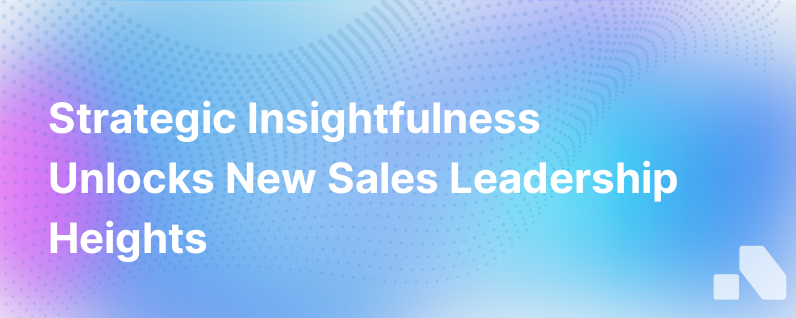
On the path to becoming a successful sales professional, it’s important to not only have a strategy but to also feel the impact of being helpful. In the world of sales, the latter is sometimes overshadowed by quotas, revenue targets, and closing tactics. Yet, a sense of contribution and utility can not only enrich your professional life, but also enhance your strategy effectively, consequently boosting your sales performance.
Understanding the Value of Helpfulness in Sales
The sales landscape has dramatically changed from what it used to be. The hard sell tactics that prioritize profits over relationships are increasingly becoming ineffective. Today, being genuinely helpful and prioritizing the client's needs is a game-changer.
When you feel that you are being helpful, it alters the dynamic of the entire sales process. Building a relationship based on trust and value rather than pressing for a quick sale reshapes the client's experience for the better.
Helpfulness starts with empathy - putting yourself in the client's shoes to understand their challenges and limitations. Next, it demands active listening to truly grasp what the client wants. Finally, it necessitates a tailor-made strategy that aligns your product's benefits with the client's objectives.
Crafting a Strategy That Reflects Helpfulness
The marriage of helpfulness and strategy in sales reflects a profound shift towards consultative selling. This approach stands on the foundation that guiding the customer through solving a problem or achieving a goal provides value that transcends the transactional exchange.
Step 1: Research and Understand Your Prospect
Before interacting with a prospect, take the time to research and understand their business. Explore their industry landscape, recent news, financial reports, social media content, and competitors. This foundational knowledge not only shows that you care but also allows you to provide tailored, actionable advice.
Step 2: Identify Pain Points and Tailor Your Solutions
Engaging directly with potential clients allows you to uncover their unique pain points and challenges. These insights should inform how you present your products or services as solutions. The strategy here hinges on customization - demonstrating how your offerings specifically address the client's concerns.
Step 3: Provide Value Beyond the Product
Establish yourself as an advisor by sharing insights, trends, and best practices relevant to the client’s industry. Offering content such as whitepapers, case studies, or webinars can help them navigate their challenges and opportunities. This further reinforces the perception of helpfulness.
Step 4: Align Your Sales Processes With Customer Expectations
Develop a sales process that mirrors the customer’s buying journey. This harmonization ensures that your interactions are timely and relevant, thereby cementing your role as a valued partner, not just a vendor.
Step 5: Create Feedback Loops
Stay connected with clients to gauge their satisfaction and openness to potential upsell or cross-sell opportunities. Open channels for feedback reflect transparency and commitment to improvement.
Measuring the Impact of Your Strategy
Implementing a strategy that prioritizes helpfulness is one side of the coin; measuring its effectiveness is the other. Key metrics such as customer satisfaction scores (CSAT), Net Promoter Scores (NPS), customer retention rates, and qualitative feedback provide insight into the impact of your approach.
More importantly, tracking these metrics over time can inform continuous adjustments to your strategy. The goal is to always iterate towards better alignment with your clients' evolving needs.
Quantitative measures like sales cycle duration and win rates will also reflect the efficiency and effectiveness of your strategy. How fast are deals closing? Are there increases in the average deal size? These metrics tie back to how well clients perceive the value and support you provide them.
Helpfulness In Action: Case Study Example
Let’s consider a hypothetical case study: a SaaS startup providing project management tools. The startup implemented a sales strategy rooted in helpfulness and personalized engagement. They trained their sales team to conduct in-depth research on each prospect and to understand their unique project management challenges.
During sales calls, instead of focusing on features, the sales reps would discuss the prospect’s ongoing projects and suggest ways to streamline their processes, even including non-software related suggestions. This helped the prospects see the sales reps as trusted advisors. The result? A 40% increase in closed deals and a higher average subscription plan tier for new clients.
Leveraging Technology for a Helpful Strategy
Utilizing modern tools and platforms can augment your ability to be helpful. For instance, Aomni, an AI-driven sales platform, can process vast amounts of data and provide real-time insights that align with the pain points of the customers. Such platforms can streamline research, keep the customer information updated, and suggest personalized sales content, drastically reducing the time required for preparatory work and allowing you to focus more on building meaningful relationships.
Recap
A sense of helpfulness combined with an effective strategy can lift your sales results beyond expectations. As a sales professional, nurturing the mindset of being a beneficial figure in your customer's professional journey is a transformative experience. It's about understanding and empathizing with the customer, customizing solutions to their particular circumstances, and providing ongoing value that cements robust, lasting relationships.
In conclusion, embracing helpfulness can redefine your sales identity. It surpasses the transactional limits and enters the realm of creating genuine value - leading not only to better sales numbers but also to a sense of fulfillment in your sales efforts. You leave not just with a closed deal but with the satisfaction of having made a positive impact. And when your strategy embodies these principles, the sales journey evolves into a mutually beneficial partnership - the core of every successful business transaction.